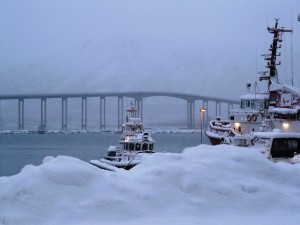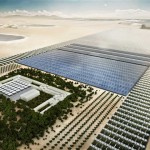Now Boarding
 Whether it's to escape cold weather, visit family or friends or explore a new place, a lot of you out there probably have a trip or planned this winter. And chances are that most of you will be flying to get to your destination. Millions of people are in the air everyday, and unfortunately that has serious consequences for our environment.
Whether it's to escape cold weather, visit family or friends or explore a new place, a lot of you out there probably have a trip or planned this winter. And chances are that most of you will be flying to get to your destination. Millions of people are in the air everyday, and unfortunately that has serious consequences for our environment.
Back in 2008, the UN Intergovernmental Panel on Climate Change put out some alarming statistics on flying: every year, planes burn around 130 million tons of fuel. If you think that's bad, that number is supposed to climb to 450 million tons by the year 2050. Of course, many airlines out there are working to make their planes more green-friendly by doing things like eliminating pollutants from jet exhaust and developing bio-fuel technology.
But what can you do? Flying is unavoidable sometimes–taking a bus or a train just isn't an option for some trips. But you can be more aware of the impact your flights have on the environment. Here at Global Ideas, we have a useful emissions calculator that gives you an idea how much each flight you take is contributing to global warming. In fact, we use this calculator to offset our own trips!
Get properly educated – and switch off!
green.tv has launched a music channel that features songs that are green meaning that they have the educational message of saving our environment. In the early 80s MTV kicked off with a metaphorical jab against radio – a video of the song 'Video killed the radio star' by the Buggles. MTV's product – "Music goes TV" – proved highly successful. It seems that green.tv now wants to inititiate another twist to the story: music TV goes green. And the video above is supposed to get the ball rolling.
Swedish producer and DJ, Eric Prydz, did a remix of Pink Floyd's 'Another Brick in the Wall' focusing on the 'education' part of the lyrics. The tune's called 'Proper Education' and it has a strong green message: switch off appliances, change light bulbs for energy efficient alternatives and put a brick into your toilet cistern (so it fills up faster and uses less water). Besides, the tune is quite catchy.
The Gateway to the Arctic?
 I have just about thawed out enough to write this, having spent a couple of hours taking pictures and recording sound in the beautiful but chilly twilight of an Arctic afternoon in January. I’m reporting for Deutsche Welle from "Arctic Frontiers". Now what does that bring to your mind? Northern countries squabbling about territory? Or the frontiers posed by snow, ice and extreme conditions to all but explorers, adventurers and the hardiest of scientists? A conference is probably the last thing that comes to mind – unless, like me, you are into the science and politics of the Arctic region.
I have just about thawed out enough to write this, having spent a couple of hours taking pictures and recording sound in the beautiful but chilly twilight of an Arctic afternoon in January. I’m reporting for Deutsche Welle from "Arctic Frontiers". Now what does that bring to your mind? Northern countries squabbling about territory? Or the frontiers posed by snow, ice and extreme conditions to all but explorers, adventurers and the hardiest of scientists? A conference is probably the last thing that comes to mind – unless, like me, you are into the science and politics of the Arctic region.
 Every year at this time, when people in the Arctic celebrate the "return of the sun" after the long dark Northern winter (it stays light from around 9.30 until nearly three at the moment), the Arctic Frontiers conference brings scientists, politicians, decision-makers, students and NGOs to Tromsö, two hours flight from the Norwegian capital Oslo and in the Arctic Circle. The town likes to be known as Norway’s "gateway to the Arctic". Historically, it has been the base for Arctic expeditions and still is. A lot of the more "comfort-loving" travellers who pass through nowadays are tourists on cruise ships. And the way the climate is changing, Tromsö is likely to be the departure point or maritime "crossroads" for a lot more travellers – and a lot more goods, in the not too distant future.
Every year at this time, when people in the Arctic celebrate the "return of the sun" after the long dark Northern winter (it stays light from around 9.30 until nearly three at the moment), the Arctic Frontiers conference brings scientists, politicians, decision-makers, students and NGOs to Tromsö, two hours flight from the Norwegian capital Oslo and in the Arctic Circle. The town likes to be known as Norway’s "gateway to the Arctic". Historically, it has been the base for Arctic expeditions and still is. A lot of the more "comfort-loving" travellers who pass through nowadays are tourists on cruise ships. And the way the climate is changing, Tromsö is likely to be the departure point or maritime "crossroads" for a lot more travellers – and a lot more goods, in the not too distant future.
 The melting of the Arctic sea ice, a lot faster than anticipated, is making the remote wilderness of this ecologically fragile region much more easily accessible. US rear admiral Dave Titley said in a presentation here the US navy reckons with a whole month of summer with no sea ice as early as 2030. That date has been continually coming forward in recent years. The question is what it will mean for the Arctic – and the rest of the planet. "Arctic Tipping Points" is the title of this year’s conference – which goes on for a whole week, with a political and a science segment. The Arctic plays a key role in regulating the world’s climate. Scientists are trying to work out when key factors – like the melting of the sea ice, which also acts as a protective cover, reflecting heat from the sun back up and away from the earth – could reach a "tipping point", or point of no return, triggering further warming as the darker ocean absorbs more heat. One study quoted here says 6 of 14 elements identified as "tipping elements" in the "earth system" are located in the Arctic.
The melting of the Arctic sea ice, a lot faster than anticipated, is making the remote wilderness of this ecologically fragile region much more easily accessible. US rear admiral Dave Titley said in a presentation here the US navy reckons with a whole month of summer with no sea ice as early as 2030. That date has been continually coming forward in recent years. The question is what it will mean for the Arctic – and the rest of the planet. "Arctic Tipping Points" is the title of this year’s conference – which goes on for a whole week, with a political and a science segment. The Arctic plays a key role in regulating the world’s climate. Scientists are trying to work out when key factors – like the melting of the sea ice, which also acts as a protective cover, reflecting heat from the sun back up and away from the earth – could reach a "tipping point", or point of no return, triggering further warming as the darker ocean absorbs more heat. One study quoted here says 6 of 14 elements identified as "tipping elements" in the "earth system" are located in the Arctic.
Other speakers – like the Rear Admiral – have other interpretations of "tipping points" – like the Arctic "tipping" from being a remote inaccessible area into a mainstream region for (literally) "business as usual". Well not quite as usual. This remains a harsh and dangerous environment. But the business opportunities are definitely there. And what do the conservationists, NGOs and indigenous communities up here have to say about all this? Join me for regular updates on the Ice Blog.
Conservation in Tanzania
The Tanzania Land Conservation Trust, or TLCT, works to preserve and protect wildlife, including Lake Manyara National Park, Tarangire National Park, and all the surrounding land. One of the TLCT's most effective projects has been its work on Manyara Ranch, a 44,000-acre piece of land it took over in 2001.
TLCT, which was created by the African Wildlife Foundation, instituted a series of conservation projects to both protect the region's wildlife and focus on making the Manyara Ranch area better for the communities who live on the land. They've worked to restore the habitat, thanks to both private and local initiatives.
And that hard work has paid off so far. The local farmers have witnessed a revival in their livestock populations, and now they manage cattle in a "conservation-friendly" way. They also moved a school from the wildlife lands to a safer area, to cut down on human-wildlife conflicts. Plus, they created a luxury safari camp to invite a small group of visitors to experience the wildlife–so you can check out Manyara Ranch and the surrounding areas yourself!
Do you have similar conservation projects near you? Or is your region in need of wildlife protection?
Jordan’s Green Machine
Jordan's government has approved a revolutionary new green project that could transform the country's desert into a green oasis and provide basic necessities like food and water to boot. An environmental technology group called the 'Sahara Forest Project' is creating a massive facility in the desert city of Aqba that promises to turn transform sun and seawater into food, energy and clean drinking water.
And to top it all off, the facility could combat climate change too by pulling in large amounts of carbon dioxide from the atmosphere. An MSN article on the project describes more of the details, including how the solar power plant and the greenhouse system will work.
The facility in Aqba will actually be a demo plant so developers can see how it works before creating more. And it could be up and running as early as 2012. Is this the way of the future for desert landscapes? Would this kind of project work in your country?









Feedback